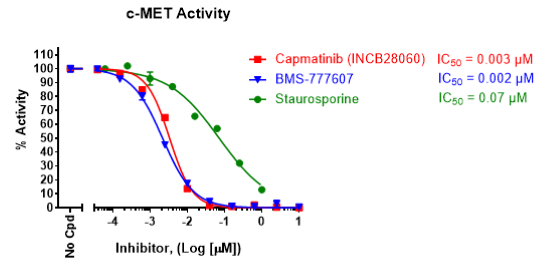Chemi-Verse™ c-MET Kinase Assay Kit
The Chemi-Verse™ c-MET Kinase Assay Kit is designed to measure c-MET (mesenchymal-epithelial transition) tyrosine kinase activity for screening and profiling applications using ADP-Glo™ as a detection reagent. The assay kit comes in a convenient 96-well format, with enough purified c-MET (amino acids 956-1390), kinase substrate, ATP, and kinase assay buffer for 100 enzyme reactions.
Need us to run inhibitor screens or profile your compounds against c-MET? Check out our Kinase Screening Services.
- ADP-Glo™ Kinase Assay (Promega #V6930)
- DTT (Dithiothreitol), 1M, optional
- Microplate reader capable of reading luminescence
- Adjustable micropipettor and sterile tips
- 30°C incubator
| Catalog # | Name | Amount | Storage |
| 40255 | c-MET, GST-Tag* | 2 µg | -80°C |
| 79334 | 5x Kinase Buffer 1 | 1.5 ml | -20°C |
| 79686 | 500 µM ATP | 50 µl | -20°C |
| 40217 | PTK substrate Poly(Glu:Tyr 4:1) (10 mg/ml) | 50 µl | -20°C |
| 82545 | White 96-well plate | 1 | Room Temp |
*The concentration of the protein is lot-specific and will be indicated on the tube.
c-Met (mesenchymal-epithelial transition), also known as HGFR (hepatocyte growth factor receptor), is a receptor tyrosine kinase (RTK) encoded by the gene MET. It is formed as a single chain precursor that undergoes proteolytic cleavage to form a glycosylated heterodimer. Upon binding the ligand HGF (hepatocyte growth factor), c-Met forms a dimer that can undergo autophosphorylation and activates the MAPK (mitogen-activated protein kinase) signaling pathway, and thus multiple cellular processes including proliferation, adhesion, angiogenesis and EMT (epithelial-mesenchymal transition). Importantly, c-Met is overexpressed in various carcinomas, suggesting that the HGF/c-Met signaling pathway could be a promising target for cancer treatment. A splice mutation that results in skipping exon 14 has been identified in the tumor tissue of approximately 4% of patients with lung cancer, particularly those with non-small cell lung cancer (NSCLC). This mutation causes over-expression of MET protein and increased MET activation, leading to oncogenesis. Interestingly, it also seems to be required for neutrophil cytotoxicity, and so its inhibition also impacts the role of neutrophils in cancer treatment. Further studies into the role of this protein and strategies to target it will open new therapeutic avenues in oncology.
Recondo G., et al., 2020 Cancer Discov. 10(7): 922-934.
Awad M.M., et al., 2016 J. Clin. Oncology 34: 721-30.
Faiella A., et al., 2022 J Oncol: 5179182.


